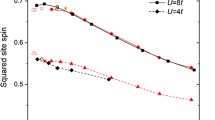Abstract.
In purely repulsive, C 4v -symmetric Hubbard clusters a correlation effect produces an effective two-body attraction and pairing; the key ingredient is the availability of W=0 pairs, that is, two-body solutions of appropriate symmetry. We study the tunneling of bound pairs in rings of 5-site units connected by weak intercell links; each unit has the topology of a CuO4 cluster and a repulsive interaction is included on every site. Further, we test the superconducting nature of the response of this model to a threading magnetic field. We present a detailed numerical study of the two-unit ring filled with 6 particles and the three-unit ring with 8 particles; in both cases a lower filling yields normal behavior. In previous studies on 1d Hubbard chains, level crossings were reported (half-integer or fractional Aharonov-Bohm effect) which however cannot be due to superconducting pairs. In contrast, the nontrivial basis of clusters carrying W=0 pairs leads to genuine Superconducting Flux Quantization (SFQ). The data are understood in terms of a cell-perturbation theory scheme which is very accurate for weak links. This low-energy approach leads to an effective hard core boson Hamiltonian which naturally describes itinerant pairs and SFQ in mesoscopic rings. For the numerical calculations, we take advantage of a recently proposed exact diagonalization technique which can be generally applied to many-fermion problems and drastically reduces the size of the matrices to be handled.
Similar content being viewed by others
References
Y. Aharonov, D. Bohm, Phys. Rev. 115, 485 (1959)
R.M. Fye, M.J. Martins, D.J. Scalapino, J. Wagner, W. Hanke, Phys. Rev. B 44, 6909 (1991)
F.V. Kusmartsev, J. Phys.: Condens. Matter 3, 3199 (1991)
A.J. Schofield, J.M. Wheatley, T. Xiang, Phys. Rev. B 44, 8349 (1991)
N. Yu, M. Fowler, Phys. Rev. B 45, 11795 (1992)
F.V. Kusmartsev, J.F. Weisz, R. Kishore, M. Takahashi, Phys. Rev. B 49, 16234 (1994)
E.H. Lieb, F. Wu, Phys. Rev. Lett. 20, 1445 (1968)
A. Ferretti, I.O. Kulik, A. Lami, Phys. Rev. B 45, 5486 (1992)
F. Nakano, J. Phys. A 33, 5429 (2000)
A. Sudb, C.M. Varma, T. Giamarchi, E.B. Stechel, R.T. Scalettar, Phys. Rev. Lett. 70, 978 (1993)
L. Arrachea, A.A. Aligia, Phys. Rev. Lett. 73, 2240 (1994)
L. Arrachea, A.A. Aligia, E. Gagliano, Phys. Rev. Lett. 76, 4396 (1996)
A. Ferretti, I.O. Kulik, A. Lami, Phys. Rev. B 47, 12235 (1993)
G.S. Canright, S.M. Girvin, Int. J. Mod. Phys. B 3, 1943 (1989)
F.F. Assaad, W. Hanke, D.J. Scalapino, Phys. Rev. Lett. 71, 1915 (1993)
L. Arrachea, A.A. Aligia, Phys. Rev. B 61, 9686 (2000)
P.W. Anderson, Science 235, 1196 (1987)
M. Cini, G. Stefanucci, A. Balzarotti, Eur. Phys. J. B 10, 293 (1999)
M. Cini, G. Stefanucci, A. Balzarotti, Solid State Commun. 109, 229 (1999)
D. Zanchi, H.J. Schulz, Z. Phys.: Condens. Matter B 103, 339 (1997)
C.J. Halboth, W. Metzner, Phys. Rev. B 61, 7364 (2000)
C. Honerkamp, M. Salmhofer, N. Furukawa, T.M. Rice, Phys. Rev. B 63, 035109 (2001)
N.E. Bickers, D.J. Scalapino, S.R. White, Phys. Rev. Lett. 62, 961 (1989)
W. Fettes, I. Morgensten, Eur. Phys. J. B 9, 635 (1999) and references therein
M. Cini, A. Balzarotti, Il Nuovo Cimento D 18, 89 (1996)
M. Cini, A. Balzarotti, J. Phys. C 8, L265 (1996)
M. Cini, A. Balzarotti, Solid State Comm. 101, 671 (1997)
M. Cini, A. Balzarotti, Phys. Rev. B 56, 14711 (1997)
F.C. Zhang, T.M. Rice, Phys. Rev. B 37, 3759 (1988)
M. Arjunwadkar, G. Baskaran, R. Basu, V.N. Mathumukar, Phys. Rev. Lett. 70, 674 (1993)
M. Cini, G. Stefanucci, E. Perfetto, A. Callegari, J. Phys.: Cond. Matt. 14, L709 (2002)
M. Cini, A. Balzarotti, G. Stefanucci, Eur. Phys. J. B 14, 269 (2000)
S. Mazumdar, F. Guo, D. Guo, K.C. Ung, J.T. Gammel, Proceeding of the Discussion meeting on strongly correlated electron systems in chemistry, Bangalore, India (Springer Verlag 1996)
W. Kohn, J. Luttinger, Phys. Rev. Lett. 15, 524 (1965)
R. Shankar, Rev. Mod. Phys. 66, 129 (1994)
A.V. Chubukov, Phys. Rev. B 48, 1097 (1993)
E. Perfetto, G. Stefanucci, M. Cini, Phys. Rev. B 66, 165434 (2002)
H.B. Schttler, A.J. Fedro, Phys. Rev B 45, 7588 (1992)
J.H. Jefferson, H. Eskes, L.F. Feiner, Phys. Rev. B 45, 7959 (1992)
V.J. Emery, Phys. Rev. Lett. 58, 2794 (1987)
F. Bloch, Z. Physik 61, 206 (1930)
L. Hulthen, Arkiv. Mat. Astron. Fysik 26 A, No. 11 (1938)
R. Orbach, Phys. Rev. 112, 309 (1958)
H.A. Bethe, Z. Physik 71, 205 (1931)
C.N. Yang, C.P Yang, Phys. Rev. 147, 303 (1966)
B.S. Shastry, B. Sutherland, Phys. Rev. Lett. 65, 243 (1990)
R. Micnas, J. Ranninger, S. Robaszkiewicz, Rev. Mod. Phys. 62, 113 (1990)
A.A. Aligia, Phys. Rev. B 61, 7028 (2000)
E.H. Lieb, Phys. Rev. Lett. 62, 1201 (1989)
W.A. Little, R.D. Parks, Phys. Rev. Lett. 9, 9 (1962)
W. Kohn, Phys. Rev. 133, A171 (1964)
E. Dagotto, Rev. Mod. Phys. 66, 763 (1994)
Using as above \(U=5 t\) one finds \(E^{(0)}_{CuO_4}(2)=-3.13962 t\), and \(E^{(0)}_{CuO_4}(4)=-2.708931 t\)
Author information
Authors and Affiliations
Corresponding author
Additional information
Received: 14 July 2003, Published online: 9 September 2003
PACS:
71.27.+a Strongly correlated electron systems; heavy fermions - 74.20.Mn Nonconventional mechanisms - 73.22.-f Electronic structure of nanoscale materials: clusters, nanoparticles, nanotubes, and nanocrystals
Rights and permissions
About this article
Cite this article
Callegari, A., Cini, M., Perfetto, E. et al. Symmetric Hubbard systems with superconducting magnetic response. Eur. Phys. J. B 34, 455–466 (2003). https://doi.org/10.1140/epjb/e2003-00244-x
Issue Date:
DOI: https://doi.org/10.1140/epjb/e2003-00244-x




